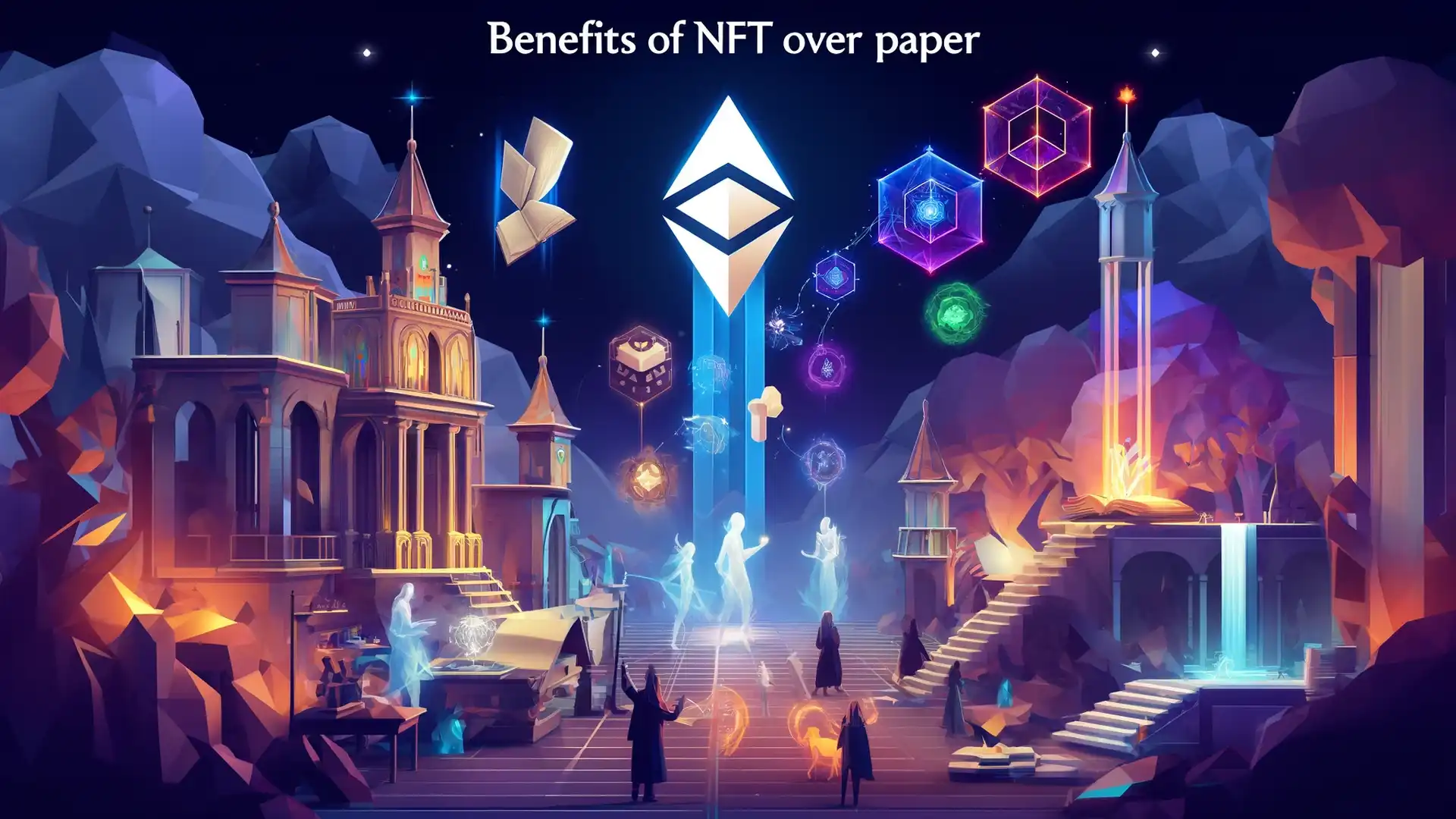Comparing NFT Credentials to Traditional Paper Credentials: Which Is Better and Why?

 Author:
Artem Grigoriev
Author:
Artem Grigoriev
The Digital Frontier: NFT Credentials vs. Traditional Paper Credentials
In the evolving world of credentialing, the introduction of Non-Fungible Tokens (NFTs) marks a modern approach that stands in stark contrast to traditional paper credentials. This chapter explores the key differences, major advantages, and potential drawbacks of each system, providing a comprehensive view of how both types of credentials function and coexist in today's increasingly digital environment.
📘 This article complements: "The Complete Guide to NFT Credentials". Explore it to find answers to all your questions;)
NFT credentials are founded on advanced cryptographic technology that securely encodes information, providing a level of security unmatched by traditional paper methods. Each NFT is permanently linked to a unique, immutable record on the blockchain, rendering forgery and tampering nearly impossible. This level of security is enhanced by technologies such as digital signatures and hash functions. Digital signatures act as a form of electronic verification, while hash functions serve as digital fingerprints, both crucial for the secure and reliable nature of blockchain transactions. A study by the European Commission suggests that blockchain could significantly reduce academic fraud by offering a more secure and transparent method for managing credentials. The robust security of NFTs safeguards against common risks associated with paper credentials, such as physical damage, loss, or fraudulent copying, ensuring each credential is secure from tampering and consistently verifiable, significantly enhancing trust in credential systems.
The benefits of NFT credentials also include their global accessibility . Digital credentials can be accessed globally with internet access, which is particularly beneficial for international professionals and students. Moreover, their digital nature allows NFTs to be stored in a digital wallet, facilitating their sharing with potential employers or educational institutions while avoiding the risks associated with physical handling. According to research from the World Bank , the rising global mobility for work and study underscores the need for portable credentials that are recognized across borders without bureaucratic delays. This digital accessibility enhances the mobility and global competitiveness of professionals and students.
Another significant advantage of NFT credentials is the efficiency of their verification processes . The ability to instantly verify qualifications expedites administrative tasks, lessening the burden on institutions responsible for credential checks. This rapid verification can greatly enhance the administrative efficiency of educational and professional organizations, enabling faster decision-making and better resource allocation. Instant verification is particularly crucial in fields like healthcare and technology, where swift confirmation of credentials is essential.
From an environmental standpoint, NFT credentials represent a step towards sustainability by eliminating the need for paper, ink, and physical storage, considerably reducing the carbon footprint associated with producing and maintaining paper credentials. However, it's important to consider the energy consumption of blockchain technology. Efforts to mitigate this include developing more energy-efficient consensus mechanisms like proof of stake. The International Energy Agency notes that blockchain projects are increasingly adopting these greener protocols, which could potentially lead to a more sustainable approach to digital transactions and record-keeping. The adoption of such technologies demonstrates the potential for NFTs to contribute to a sustainable credentialing future.
💡 Note: While NFTs offer enhanced security and environmental benefits, ongoing efforts are needed to address the significant energy consumption of some blockchain networks.

Conversely, traditional paper credentials still hold considerable value, particularly favored for their simplicity in issuance and widespread acceptance. In many parts of the world, paper credentials are preferred due to their tangible nature and the absence of necessary technological infrastructure. They also carry ceremonial and traditional significance, especially in formal educational events like graduations, where the physical presentation of a diploma is a cherished tradition.
The legal recognition of paper credentials is currently more established across various regions compared to NFTs. This presents a challenge for the broader acceptance of digital credentials. Developing legal frameworks to support new technologies and ensure their recognition across borders is crucial. Efforts in this domain are essential, as underscored by the UNESCO Digital Transformation of Education system, emphasizing the need for legal adaptability to embrace technological advances in education.
This chapter offers a balanced examination of the strengths and challenges associated with both NFT and traditional paper credentials. By understanding their specific benefits and limitations, readers can recognize the potential for NFTs to transform credential management while acknowledging the ongoing relevance of traditional methods in the global context.
💡 Tip: Stakeholders looking to transition to NFT-based credential systems should consult with legal experts to help navigate the complex regulatory landscape and promote wider acceptance and integration of digital credentials.

The Digital Frontier: NFT Credentials vs. Traditional Paper Credentials
In the evolving world of credentialing, the introduction of Non-Fungible Tokens (NFTs) marks a modern approach that stands in stark contrast to traditional paper credentials. This chapter explores the key differences, major advantages, and potential drawbacks of each system, providing a comprehensive view of how both types of credentials function and coexist in today's increasingly digital environment.
NFT credentials are founded on advanced cryptographic technology that securely encodes information, providing a level of security unmatched by traditional paper methods. Each NFT is permanently linked to a unique, immutable record on the blockchain, rendering forgery and tampering nearly impossible. Enhancements such as digital signatures and hash functions bolster this security. Digital signatures act as a form of electronic verification, while hash functions serve as digital fingerprints, both crucial for the secure and reliable nature of blockchain transactions. A study by the European Commission suggests that blockchain could significantly reduce academic fraud, offering a more secure and transparent method for managing credentials. The robust security of NFTs safeguards against common risks associated with paper credentials, such as physical damage, loss, or fraudulent copying, ensuring each credential is secure from tampering and consistently verifiable, significantly enhancing trust in credential systems.
The benefits of NFT credentials include their accessibility and portability . Digital credentials can be accessed globally with internet access, which is particularly beneficial for international professionals and students. Moreover, their digital nature allows NFTs to be stored in a digital wallet, facilitating their sharing with potential employers or educational institutions while avoiding the risks associated with physical handling. According to research from the World Bank , the rising global mobility for work and study underscores the need for portable credentials that are recognized across borders without bureaucratic delays, enhancing the mobility and global competitiveness of professionals and students.
Another significant advantage of NFT credentials is the efficiency of their verification processes . The ability to instantly verify qualifications expedites administrative tasks, lessening the burden on institutions responsible for credential checks. This rapid verification enhances the administrative efficiency of educational and professional organizations, enabling faster decision-making and better resource allocation. Instant verification is particularly crucial in fields like healthcare and technology, where swift confirmation of credentials is essential.
From an environmental standpoint, NFT credentials represent a step towards sustainability by eliminating the need for paper, ink, and physical storage, considerably reducing the carbon footprint associated with producing and maintaining paper credentials. However, it's important to consider the energy consumption of blockchain technology. Efforts to mitigate this include developing more energy-efficient consensus mechanisms like proof of stake. The International Energy Agency notes that blockchain projects are increasingly adopting these greener protocols, which could potentially lead to a more sustainable approach to digital transactions and record-keeping. The adoption of such technologies demonstrates the potential for NFTs to contribute to a sustainable credentialing future.
💡 Note: While NFTs offer enhanced security and environmental benefits, ongoing efforts are needed to address the significant energy consumption of some blockchain networks.

Conversely, traditional paper credentials still hold considerable value, particularly favored for their simplicity in issuance and widespread acceptance. In many parts of the world, paper credentials are preferred due to their tangible nature and the absence of necessary technological infrastructure. They also carry ceremonial and traditional significance, especially true in formal educational events like graduations, where the physical presentation of a diploma is a cherished tradition.
The legal recognition of paper credentials is currently more established across various regions compared to NFTs. This presents a challenge for the broader acceptance of digital credentials. Developing legal frameworks to support new technologies and ensure their recognition across borders is crucial. Efforts in this domain are essential, as underscored by the UNESCO Digital Transformation of Education system, emphasizing the need for legal adaptability to embrace technological advances in education.
This chapter offers a balanced examination of the strengths and challenges associated with both NFT and traditional paper credentials. By understanding their specific benefits and limitations, readers can recognize the potential for NFTs to transform credential management while also acknowledging the ongoing relevance of traditional methods in the global context.
💡 Tip: Stakeholders looking to transition to NFT-based credential systems should consult with legal experts to help navigate the complex regulatory landscape and promote wider acceptance and integration of digital credentials.

The Power of NFT Rewards: Boosting Engagement and Loyalty in Education
Step-by-Step Guide to Creating, Issuing, and Implementing NFT Credentials
What Is TTP (Trusted Third Party) and Why It's Essential for NFT Credential Verification
NFT and Blockchain in Education: How are they used and why?
Technical Requirements and Specifications for Creating, Issuing, and Implementing NFT Credentials in Education
